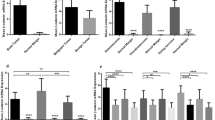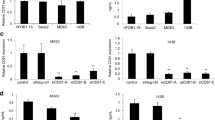Abstract
Beta-catenin is involved in cell motility in the extracellular matrix, and is expressed in normal and neoplastic mesenchymal cells. In order to clarify whether beta-catenin expression in the cytoplasm and/or nucleus is associated with a propensity for pulmonary metastasis in osteosarcoma, the LM8 murine osteosarcoma cell line with a high metastatic potential to the lung was compared with original Dunn cells in terms of the beta-catenin expression level. Both osteosarcoma cell lines lost membrane localization of beta-catenin. However, beta-catenin gene had no mutation in exon 3 by direct sequence analysis. A large number of LM8 cells showed diffuse cytoplasmic and/or nuclear staining of beta-catenin (30.8 per high power field (HPF)), while a much smaller number of Dunn cells showed expression of beta-catenin (7.7 per HPF). Cells with positive staining of beta-catenin were frequently seen at the invasive front and in intravenous tumor deposits within the metastatic lesions to the lung. Thus, LM8 cells express a larger amount of the beta-catenin protein than Dunn cells, as judged by immunoblot analysis. In five resected cases of pulmonary metastasis, translocation of beta-catenin to the cytoplasm and/or nucleus of osteosarcoma cells was detected, although seven primary osteosarcomas cells that did not metastasize for more than five years did not show beta-catenin expression. These data indicate that the cytoplasmic and/or nuclear staining of beta-catenin is a biological marker of metastatic potential of osteosarcoma to the lung.
Similar content being viewed by others
References
Gumbiner BM. Cell adhesion: The molecular basis of tissue architecture and morphogenesis. Cell 1996; 84: 345–57.
Behrens J, von Kries JP, Kuhl M et al. Functional interaction of betacatenin with the transcription factor LEF-1. Nature 1996; 382: 638–42.
Morin PJ, Sparks AB, Korinek V et al. Activation of beta-catenin-Tcf signaling in colon cancer by mutations in beta-catenin or APC. Science 1997; 275: 1787–90.
Takahashi M, Fukuda K, Sugimura T et al. Beta-catenin is frequently mutated and demonstrates altered cellular location in azoxymethaneinduced rat colon tumors. Cancer Res 1998; 58: 42–6.
Garcia-Rostan G, Tallini G, Herrero A et al. Frequent mutation and nuclear localization of beta-catenin in anaplastic thyroid carcinoma. Cancer Res 1999; 59: 1811–5.
He TC, Sparks AB, Rago C et al. Identification of c-MYC as a target of the APC pathway. Science 1998; 281: 1509–12.
Tetsu O, McCormick F. Beta-catenin regulates expression of cyclin D1 in colon carcinoma cells. Nature 1999; 398: 422–6.
Brabletz T, Jung A, Dag S et al. Beta-catenin regulates the expression of the matrix metalloproteinase-7 in human colorectal cancer. Am J Pathol 1999; 155: 1033–8.
Miyazawa K, Iwaya K, Kuroda K et al. Nuclear accumulation of betacatenin in intestinal-type gastric carcinoma: correlation with early tumor invasion. Virchows Arch 2000; 437: 508–13.
Ramesh S, Nash J, McCulloch PG. Reduction in membranous expression of beta-catenin and increased cytoplasmic E-cadherin expression predict poor survival in gastric cancer. Br J Cancer 1999; 81: 1392–7.
Peralta Soler A, Knudsen KA, Salazar H et al. P-cadherin expression in breast carcinoma indicates poor survival. Cancer 1999; 86: 1263–72.
Hirohashi S. Inactivation of the E-cadherin-mediated cell adhesion system in human cancers. Am J Pathol 1998; 153: 333–9.
Kawaguchi J, Takeshita S, Kashima T et al. Expression and function of the splice variant of the human cadherin-11 gene in subordination to intact cadherin-11. J Bone Miner Res 99; 14: 764–75.
Kashima T, Kawaguchi J, Takeshita S et al. Anomalous cadherin expression in osteosarcoma. Possible relationships to metastasis and morphogenesis. Am J Pathol 1999; 155: 1549–55.
Asai T, Ueda T, Itoh K et al. Establishment and characterization of a murine osteosarcoma cell line (LM8) with high metastatic potential to the lung. Int J Cancer 1998; 76: 418–22.
Lefebvre AM, Chen I, Desreumaux P et al. Activation of the peroxisome proliferator-activated receptor gamma promotes the development of colon tumors in C57BL/6J-APCMin/+ mice. Nat Med 1998; 4: 1053–7.
Kim K, Daniels KJ, Hay ED. Tissue-specific expression of betacatenin in normal mesenchyme and uveal melanomas and its effect on invasiveness. Exp Cell Res 1998; 245: 79–90.
Blankesteijn WM, van Gijn ME, Essers-Janssen YP et al. Betacatenin, an inducer of uncontrolled cell proliferation and migration in malignancies, is localized in the cytoplasm of vascular endothelium during neovascularization after myocardial infarction. Am J Pathol 2000; 157: 877–83.
Whitehead I, Kirk H, Kay R. Expression cloning of oncogenes by retroviral transfer of cDNA libraries. Mol Cell Biol 1995; 15: 704–10.
Young CS, Kitamura M, Hardy S et al. Wnt-1 induces growth, cytosolic beta-catenin, and Tcf/Lef transcriptional activation in Rat-1 fibroblasts. Mol Cell Biol 1998; 18: 2474–85.
Iwao K, Miyoshi Y, Nawa G et al. Frequent beta-catenin abnormalities in bone and soft-tissue tumors. Jpn J Cancer Res 1999; 90: 205–9.
Omholt K, Platz A, Ringborg U et al. Cytoplasmic and nuclear accumulation of beta-catenin is rarely caused by CTNNB1 exon 3 mutation in cutaneous malignant melanoma. Int J Cancer 2001; 92: 839–42.
Murakami T, Toda S, Fujimoto M et al. Constitutive activation of Wnt/beta-catenin signaling pathway in migration-active melanoma cells: Role of LEF-1 in melanoma with increased metastatic potential. Biochem Biophys Res Commun 2001; 288: 8–15.
Hasegawa T, Yokoyama R, Matsuno Y et al. Prognostic significance of histologic grade and nuclear expression of beta-catenin in synovial sarcoma. Hum Pathol 2001; 32: 257–63.
Bielack SS, Kempf-Bielack B, Delling G et al. Prognostic factors in high-grade osteosarcoma of the extremities or trunk: An analysis of 1,702 patients treated on neoadjuvant cooperative osteosarcoma study group protocols. J Clin Oncol 2002; 20: 776–90.
Author information
Authors and Affiliations
Corresponding author
Rights and permissions
About this article
Cite this article
Iwaya, K., Ogawa, H., Kuroda, M. et al. Cytoplasmic and/or nuclear staining of beta-catenin is associated with lung metastasis. Clin Exp Metastasis 20, 525–529 (2003). https://doi.org/10.1023/A:1025821229013
Issue Date:
DOI: https://doi.org/10.1023/A:1025821229013




